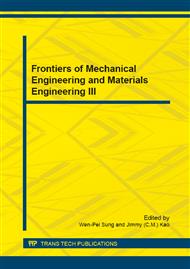[1]
A. Chiarini, Designing an environmental sustainable supply chain through ISO 14001 standard, Management of Environmental Quality: An International Journal, vol. 24, no. 1, pp.16-33, (2013).
DOI: 10.1108/14777831311291113
Google Scholar
[2]
Fraunhofer, Machine Tools and Related Machinery,. Eco Machine Tools, Task 4 Report– Assessment of Base Case, 144 p., 2012. In: http: /www. ecomachinetools. eu/typo/reports. html.
Google Scholar
[3]
A.E. Bayoumi, G. Yücesan, D.V. Hutton, On the closed form mechanistic modeling of milling: Specific cutting energy, torque, and power,. Journal of Materials Engineering and Performance, Vol. 3, No. 1, pp.151-158, (1994).
DOI: 10.1007/bf02654511
Google Scholar
[4]
A. Ersoy and U. Atici, Performace characteristics of circular diamond saws in cutting of different type of rocks. Diamond and Telated Materials, Vol. 13, No. 1, pp.22-37, (2004).
DOI: 10.1016/j.diamond.2003.08.016
Google Scholar
[5]
A. M. Y. Rigatti, C. L. F. de Assis, R. T. Coelho, R. G. Jasinevicius, A. R. Rodrigues, Computational method for calculation of the specific cutting energy,. 22nd International Congress of Mechanical Engineering (COBEM 2013), November 3-7, RibeirãoPreto, SP, Brazil, pp.2710-2715, (2013).
Google Scholar
[6]
G. Campatelli, L. Lorenzini, A. Scippa, Optimization of process parameters using a Response Surface Methodfor minimizing power consumption in the milling of carbon steel, Journal of Cleaner Production, Vol. 66, pp.309-316, (2014).
DOI: 10.1016/j.jclepro.2013.10.025
Google Scholar
[7]
J. Antony, M. Hughes, M. Kaye, Reducing manufacturing process variability using experimental design technique: a case study, Integrated Manufacturing Systems, Vol. 10, No. 3, pp.162-170, (1999).
DOI: 10.1108/09576069910264420
Google Scholar
[8]
Y-K Yang, M-T Chuang, S-S Lin, Optimization of dry machining parameters for high-purity graphite in end milling process via design of experiments methods, Journal of Materials Processing Technology, Vol. 209, No. 9, pp.4395-4400, (2009).
DOI: 10.1016/j.jmatprotec.2008.11.021
Google Scholar
[9]
K.V.B.S. Kalyan Kumar and S.K. Choudhury, Investigation of tool wear and cutting force in cryogenic machining using design of experiments, Journal of Materials Processing Technology, Vol. 203, No. 1-3, pp.95-101, (2008).
DOI: 10.1016/j.jmatprotec.2007.10.036
Google Scholar
[10]
D.C. Montgomery, Design and Analysis of Experiments, 7. Ed., John Wiley & Sons, New York, 2009, 256 p.
Google Scholar
[11]
G. Taguchi, S. Chowdhury, Y. Wu, Taguchi's Quality Engineering Handbook, 1. ed, John Wiley & Sons, New Jersey, 2004, 1696 p.
Google Scholar
[12]
S. Kalpakjian and S. R. Schmid, Manufacturing Engineering and Technology, 6. ed., PearsonPrentice-Hall, Upper Saddle River, 2010, 1176p.
Google Scholar


